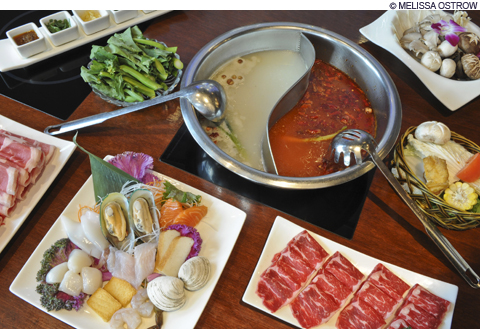
SLAM DUNK Q Restaurant has an innovative hot-pot scheme that restarts the traditional cook-it-yourself-in-broth experience. |
You be careful what you ask for, and I'll be careful what I write. The minute I try to close the book on reviewing tequila bars, the cocktail genies at Deep Ellum decide to do a new one next door. I think I'm done with hot-pot restaurants, and here comes Q Restaurant, fresh from the competitive Quincy scene, with a triply innovative scheme that restarts the whole game.I knew, through some experience, that the best thing about Mongolian hot pots is the soup at the end (so save room). But at the Q, they have this trick of starting from high-quality broth, which elevates the entire endeavor. Trick No. 2 is that they also have conventional Chinese food so good you can skip the hot pots, and 2B is that they have reasonably good sushi as well. Trick No. 3 is that this Boston restaurant is a modern, duplex lounge suitable for fancy occasions. I had long written off the hot-pot menu as a low-budget evening of dunking and spilling (and, later, dry-cleaning). Q adds so much flexibility to the concept, and does most of it so well, that it creates a new category.
Indeed, on my first visit, we had no hot pot, as there were no table seats available. So we sat at the bar eating dish after terrific dish: green-tea shrimp ($11), hauntingly tender and subtlety flavored with spent tea leaves; sautéed shiitake mushrooms on greens ($10), a gorgeous plate of deep brown on the bright green of baby bok choy arranged in a mandala; shrimp with tofu ($11), offering more subtle colors and flavors and textures, but all in harmony. Or, the opposite of subtle, Szechuan-style "beef stew" ($13), a legitimate three-chili-silhouette bowl of shaved steak, tree ears ("black fungus" here), cellophane noodles, fermented beans, lots of dried chilies, and some cardamom.
On our second visit, we had to check out the hot pots, but first we had the best Peking ravioli in Chinatown in a long time — "Japanese pot-stickers" ($5) with gossamer pasta, a light chicken-pork-ginger filling, and two dips — and a "black fungus" appetizer ($4), which was a crunchy way to get some sesame-soy flavor. We tested the Japanese side of the menu with a sashimi appetizer — three slices of a pink, thick fish (tilefish?), two of salmon, and two of a white, dense fish (or maybe a sea scallop?) — that was well cut and impeccably fresh, with all the usual details, including two leaves of shiso, the wildly flavored herb that jumps out of bland sashimi platters.